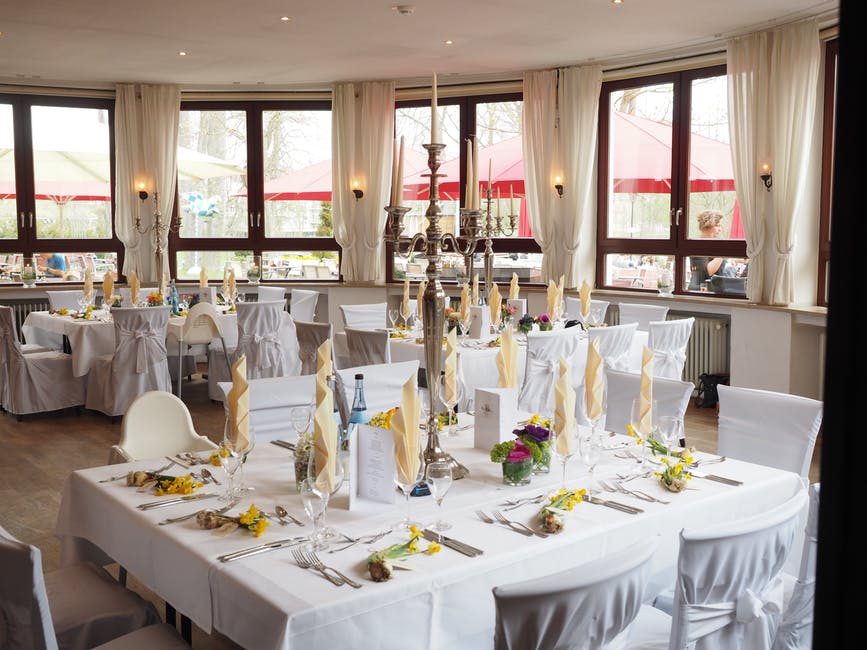Planning a wedding can be equal parts fun and challenging.
You have to pick out everything from your wedding outfit to your cake flavor, music, colors, and more. But one of the more notoriously challenging parts of planning a wedding is laying out the seating chart.
A wedding seating chart must be a delicate balance of real estate and political maneuvering. Read on to learn how to create a seating chart that will give every one of your guests the best seat in the house.
Pick a Table Shape
The first thing you should do when creating a wedding seating chart is to pick a table shape. For one thing, this will determine how you arrange your seating chart. But it will also decide things like how many tables you need, where the dance floor will be, and more.
In general, the two main wedding reception table shapes are round and square. If you want a more homey, chatty reception where folks can drift and visit among other tables, go for round or oval tables. If you want a more formal atmosphere or you’re having a large wedding, opt for square or rectangular tables.
Set Up a Head Table
No matter which table shape you pick, it’s a good idea to set up some sort of a head table. This will be where you and your new spouse sit, along with the rest of your wedding party. It will allow you to hang out with your closest friends during the reception and will give you something of a “home base” where people can find you and you can sit to eat.
If you choose rectangular tables, placing your head table at the front of the reception hall might be the best option. This will provide a very traditional arrangement and will allow your guests to look to you for guidance during the various reception events. If you have round tables, you may want to place your head table near the center of the room.
Place the Parents
The wedding party is not the only group that deserves its own table at your reception. Your parents and your spouse’s parents deserve recognition, too. This table can also be a good spot to place grandparents, siblings not in the wedding party, and other close family members.
You should place your parents near the head table. This will allow them to come chat with you and check in throughout the reception while still giving you a little space to enjoy the party with your friends. If you have family members who don’t get along, consider creating two tables and placing the contentious parties at different tables.
Get Advice
When you’re creating a wedding reception seating plan, it can feel like you’re trying to keep a thousand different plates spinning at once. You want your family together, but not everyone gets along or there isn’t enough room at adjacent tables. In some cases, you may not know who certain family members are or who they’ll get along with.
Don’t be afraid to ask for advice and help in arranging your seating plan. Talk to your parents about where to seat relatives who you don’t know especially well, and get your wedding party’s help with arranging friends. And, of course, your partner should be as involved in making your seating arrangements as you are.
Start Grouping Guests
After you’ve placed your wedding party and close family, it will be time to start tackling the rest of the guests. One great way to do this is to divide your guests into several large groups. From there, you can begin placing members of similar groups at nearby tables.
Start with major divisions such as your family, your partner’s family, college friends, friends from work, and friends from any religious or community activities. From there, you may want to take a look at personality types in each group. If you know that some of your college friends are the religious type while others are stringent atheists, you may not want to put those people at the same table.
Make a Kids’ Table
The decision about whether to invite kids to a wedding can be a tough one. On one hand, children are an important part of your guests’ (and maybe your) lives, and it can be wonderful to include them in the festivities. But on the other hand, having kids at the reception can make it more difficult for their parents to relax and enjoy the party.
Consider making a special table for the kids who will be at the reception. You can provide games, puzzles, and color sheets to keep them entertained while their parents dance. This way, the adults at your wedding can enjoy themselves without having to take shifts watching their kids.
Keep the Space in Mind
As you’re arranging your guests, you need to make sure you’re keeping the dynamics of the space in mind. There’s no one-size-fits-all seating arrangement because every space is different. Some spaces might do better with traditional white chairs, while others might shine with the addition of ghost chairs.
You may want to seat your college friends near the dance floor and your grandparents a little further away from the action. Your group of aunts may not appreciate being put at the back of the banquet hall, while your D&D group might not mind a bit. Think about the general flow of the reception hall and use that to guide where you place each group.
Create the Perfect Wedding Seating Chart
Creating a wedding seating chart is no mean feat. You have to make sure you’re placing groups that get along near each other and that everyone winds up in an area of the reception hall that will work well for them. Following the tips we’ve mentioned here can help you make sure all your guests have the best possible time at your wedding.
If you’d like to read more awesome articles like this, check out the rest of our website!











